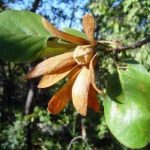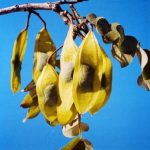TREE LIFE
April 1984
HARARE CALENDAR
Tuesday April 3rd : Botanic Garden Walk. Meet in the Car Park at 1645 hours for 1700 hours.
Sunday April 15th : A combined outing with Chegutu Branch to Peter Poulsen’s farm “Lawrence’s Kopjes”, which is sure to be an interesting trip. A bus has been arranged and will leave the Monomatapa Car Park at 0830 sharp. Fare $13.00.
MATABELELAND CALENDAR
Sunday 1st April : Upper Hillside Dam, 0830. Take the first road to the left after you come through the gate and follow it to the end.
BOTANIC GARDEN WALK, 6TH MARCH, 1984
The classification system of Engler and Prantl, with which we are familiar by reference to Coates Palgrave’s “Trees of Southern Africa”, begins the dicotyledons with those trees whose flowers lack petals, like the willow. Although this system is convenient to use, it does not always arrange plants in what is considered to be their ‘natural’ order. The highly specialized figs, for example, are placed near the beginning because they lack petals. Modern classification systems, such as Cronquist, 1981 “An integrated system of classification of flowering plants”, consider the magnolia family as one of the simplest of the dicotyledons. No MAGNOLICEAE trees are indigenous to Zimbabwe, but the closely related ANNONACEAE is well represented. In this month’s walk Tom Muller showed us the four most primitive of the indigenous dicot. families that have tree representatives: the ANNOACEAE, MONIMIACEAE, LAURACEAE and HERNANDIACEAE. The custard apple family ANNONACEAE is closely related to the MAGNOLIACEAE. We saw the typical ANNONACEAE flower in November when we examined Monodora junodii with its liver coloured petals arranged in whorls of three. This arrangement in 3’s is very unusual in the dicotyledons where the petals are usually in multiples of 4 or 5, and is considered one of the primitive characters of the family. At the time I commented on Juno, the goddess of female sensuality, in reality the Rev. Henri Junod turns out to be a Swiss Missionary who lived in Mozambique and collected specimens in Delagoa Bay in the 1890’s. So gone is the romantic imagery, I am afraid. This plant which grows in the south-east lowveld section of the gardens, also occurs beyond Mutoko in the north east.
Tom began the walk by looking at a large tree, Xylopia parviflora, a low altitude forest pioneer in the east. The trunk was characteristically twisted with horizontal branches coming out in a spiral staircase manner. The lower trunk has vertical ‘burst marks’. A very similar, and questionably different, species X. odoratissima occurs on the Kalahari sands in the west. The sweet smelling Xylopia flowers led to the discovery of the third species, X. aethiopica, a tall forest tree which was originally traced by means of its scent. Vegetatively the ANNONACEAE are one of the easiest of all families to recognize. The leaves are always single with entire margins and are arranged alternately on the stem in a characteristically prepressed fashion, a plant pressing dream, the horizontal branches holding the leaves in one plane. Often the branch zig zags slightly with each leaf and when actively growing the new leaves are folded in half down the midrib with successively smaller leaves tucked inside the largest one of the flattened bud. There are no stipules, a feature which helps to separate out those EUPHORBIACEAE which also have a flat leaf arrangement.
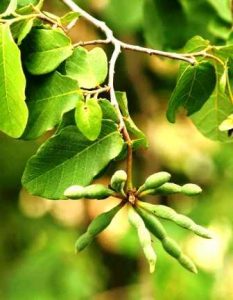
Friesodielsia obovata, Photo: Bart Wursten. Source: Flora of Zimbabwe
We noted these again in Friesodielsia obovata, a plant we encounter frequently around Harare and saw in full cream-yellow flower on Thistle Farm with the Chegutu Branch. This species often grows near rivers and in jesse bush where it sometimes scrambles over other trees. Another constituent of the dense jesse bush of the Zambezi Valley is Cleistochlomys kirkii. Besides the other ANNONACEAE characters, this plant produces a very edible fruit, a feature of many species in the family. The indigenous custard apple, Annona senegalensis is equally edible. The leaves are often circular, although many ANNONACEAE leaves tend to be obovate or egg shaped. After extensive searching Tom decided his specimens must have died.
Behind the forest on the low rocky kopjes we saw the baboon’s breakfast, Hexalobus monopetalus. In Matopos the narrow leafed variety monopetalus occurs alongside the path to Rhodes grave whereas around Harare we find the much broader leafed variety obovata. Tom has found many intermediates between these two extremes which would call into question their separate status.
Although not strictly trees we examined a number of the ANNONACEAE climbers. In many cases the definition of tree falls apart in these cases. Artabotrys climbs by means of an unusual hooked flower stalk that continues growing after the flowers have fallen, securing the scrambling branches in nearby trees. A. brachypetalus frequently grows on sand in deciduous woodland and thickets at lower altitudes the other species A. montana is similar but occurs in riverine forest in the east. Another climbing genus, Uvaria, loops around neighbouring trees instead of using flower stalks. In the forest near the Xylopia we saw Chemontotaxis chasei, which used to belong to Popowia before that became Friesodielsia, and now suits this new genus.
The next three small families are grouped together in the order Laurales. This order typically has smaller flowers which grow in ‘bunches’ in contrast to the solitary flowers of the order Magnoliales to which the ANNONACEAE belong.
Xymalos monospora is immediately recognizable by its quilted leaf and toothed margin, very different to the ANNONACEAE, This multi trunked medium storey tree of the Vumba forest is the only indigenous representative of the family MONIMIACEAE. This small family is apparently central to an understanding of the order, a complex explanation will not follow.
The laurel family, LAURACEAE contains aromatic evergreen trees and shrubs. The leaves are generally alternate and usually entire and without stipules. We are all familiar with the products of the LAURACEAE, the avocado, camphor, the classical laurel, cinnamon and oil of sassafras. In South Africa the stinkwood, Ocotea bullata is highly prized for its timber. We saw the indigenous O. kenyensis with strange fruit that resembles an English acorn. This species lacks the large black pits in the axils of the veins that are found in O. bullata.
Tom showed us two specimens of another LAURACEAE, Cryptocarya liebertiana. In the high altitude section we saw a broad leafed tree with faintly scented leaves. At lower altitude all specimens have narrow leaves. The narrow leafed tree we saw growing on the edge of the Anthocleista lawn was so different it was not possible to see many similarities
The third family in the Laurales, HERNANDIACEAE, contains the aptly named propeller tree, Gyrocarpus americanus which demonstrates the three lobed, simple leaf often found in this family. This is a deciduous tree of low altitudes..
Tom then showed us around his extensive collection of exotic ANNONACEAE.
Thanks once again for an informative walk, and thanks to Cheryl for taking notes and revising the walk with me afterwards.
-Kim ST.J.Damstra
OUTING AND A.G.M. AT JOHN JONES’ PROPERTY, TWENTYDALES, 18TH MARCH, 1984
The Annual General Meeting of the Society was held at 12 noon in conjunction with our regular monthly outing. Although no transport was laid on, I am happy to say that there was a good turnout of 36 members and a number of guests. I were especially glad to welcome Stan Fourie, Derek and Gill Henderson and Benedicta Graves who had made the journey all the way from Raffingora to represent Ayshire Branch. We are indeed grateful to John and Myra Jones for allowing us to visit their property but especially for letting us use their lawn fronting on the Ruwa river for our A.G.M.
The full minutes will be circulated before the next AGM. However it is my duty to advise members of the composition of the elected Committee as follows :
Chairman: Philip Haxen Vice Chairman Kim Damstra
Treasurer: Brian Best
Committee: Meg Coates Palgrave, George Hall, Pat Walker, Molly Kilpert, Barbara Browning,
Fr. Hugh Ross, Charles Wolstenholme.
We wish to thank Alec Dry and Cheryl Haxen the outgoing members of the Committee who served for a number of years and have always given of their best to the Society. We also wish to thank Pat Walker for her untiring efforts as Secretary over the past few years. We are grateful that whilst unable to continue as Secretary she will still serve on the Committee. With the lack of an “heir apparent” to this post it was decided to leave it to the Committee to deal with the problem either by co-opting a volunteer in due course or otherwise finding alternatives.
I have incorporated the Chairman’s Report in this newsletter while the subject matter is still fresh in our minds rather than circulating it with the Minutes at the end of the year.
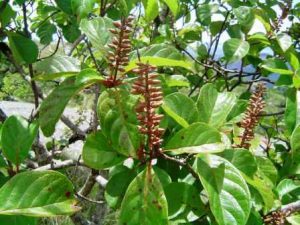
Hymenodictyon floribundum. Photo: Bart Wursten. Source: Flora of Zimbabwe
After the meeting in the morning we started our treeing activities in front of the house. Amongst the rocks was one of the rock splitting figs, Ficus natalensis with its smallish obovate leaves which sometimes look as if the tip has been snipped off. Often the tip is emarginate or indented. Close by was Canthium huilese, now Canthium lividium, complete with opposite leaves and interpetiolar stipules putting it squarely in the family RUBIACEAE. Soon after we saw another member of the same family Hymenodictyon floribundum with the same characters, although in this species the interpetiolar stipules have a row of fine black teeth along the margins. This tree also had the beginnings of the red autumn leaves which give it the common name of the “firebush” We examined an Erythrina here whose very large leaves contrasted markedly with the small leaves of another seen later in the morning. This left me in no doubt that the first one was E. latissima and the second one was E. abyssinica. Before crossing the river onto the island which we investigated we also found Ochna puberula distinguished by its small serrate-edged leaves and not so flaking bark.
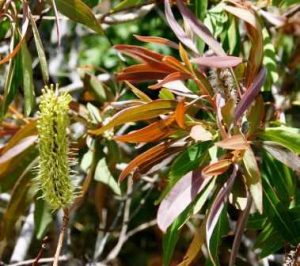
Faurea saligna. Photo: Bart Wursten. Source: Flora of Zimbabwe
On crossing the river we saw a number of dead waterberries, Syzygium cordatum. They were undoubtedly the victims of the drought. Once across the stream we encountered a fairly broad leafed Faurea saligna, PROTEACEAE. We were later to confuse this with some rather atypical Terminalia sericea. However the vein forming a continuous border around the leaf edge of the Faurea, the peeling branchlets of the Terminalia and the ‘looping’ growth form of its branches were sufficient to separate these two.
Now the embarrassment of the day. The orange berried shrubs which I insisted on calling Rhus quartiniana were of course Allophylus africanus. The berries should have offered a clue for they were round whereas Rhus fruit are often flattened. Also in orange red fruit were the Diospyros lycioides. The fruit on these though were somewhat larger and of course carried that persistent calyx, typical of Diospyros, giving the name of “star apple”. Another Diospyros seen infesting the rocky areas was D. natalensis with small, glossy, dark green round leaves which give it the name of ”tickey tree”.
A large, smooth trunked Strychnos, monkey orange, which we assumed to be S. spinosa contrasted markedly with a very corky barked specimen seen in the car park which we assume was S. cocculoides.
Another find which is difficult to call a ‘tree’ was Pterolobium stellatum which bore both spikes of creamy flowers and the maturing ‘red wing’ seeds. This creeper/liana is one of the prickliest things I know other than Mauritius Thorn. It can with age develop quite a trunk.
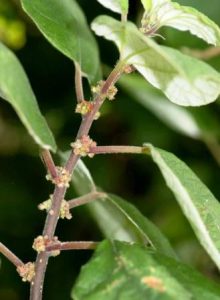
Pouzolzia hypolenca. Photo: Bart Wursten. Source: Flora of Zimbabwe
We found two plants with ‘stick-on’ leaves, i.e. the leaves which, if pressed against one’s shirt, will stick on. These were Pouzolzia hypolenca, a small tree with simple leaves whose undersides are truly silver white. The other is nothing more really, than a shrub, by the name of Pseudarthria hookeri. This is not bi coloured and is in fact trifoliate.
Further along we came upon Clerodendrum glabrum in fruit. The leaf has a rather unpleasant smell when crushed. This species exhibits a feature not present in the other Clerodendrums which is that the leaves come out in threes along the stem. Under the spreading canopy of an Acacia sieberiana nearby, was an interesting community including Celtis africana and Dovyalis zeyheri. George Hall made the observation that the success of this community was undoubtedly due in large measure to the nitrogen fixation by the leguminous Acacia. Before turning to go back we observed by Heteromorpha trifoliate and Steganotaenia araliacea both members of the parsley family UMBELLIFERAE, now APIACEAE, and both bearing the typical seeds and flower heads of ‘umbels’. Most interesting was the vaguely similar aromatic smell from the crushed leaves. On some higher ground at the lower end of the island we were shown some rather unusual aloes, Aloe Cryptopoda, this being one of the few places where they still occur naturally. Coming back to trees, it was also here that we saw Grewia flavescens with both yellow flower and four lobed fruit which gives it the common name of cross berry, the other name is donkey berry. This Grewia is unmistakable once you notice the fluted square stem. Hugh Ross then located another Grewia close by, this time with a white flower, which was Grewia stolzii, and then Benedicta Graves found G. herbacea which is a small shrub with round leaves and large fruit which, we are told, is fairly common around Harare.
During the morning some members collected specimens from a small tree with small orange fruit. The significant feature was that the leaves were peppered with black dots which were quite visible without having to hold the leaf up to the light. This is the more unusual ‘black dot tree’ Psychotria kirkii. The more common ones we see are Pavetta schumanniana which we saw in the afternoon, and P. gardeniifolia.
Although the afternoon walk was cut short by the imminent rain we managed to see a few things of interest, an Albizia antunesiana with a young fig Ficus thonningii growing out of the middle of a fork in the trunk, one day to strangle the host, no doubt; a tree sized Psorospermum febrifugum; the yellow blooded Garcinia buchananii and Protea angolensis with relatively broad leaves and pink petioles. I wonder how many people noticed the protea P. welwitschii just beyond the gate and grid on the way out with a lovely show of creamy coloured flowers?
Despite the threat of rain, it never did come down, which cut short our day, we all had a most enjoyable day for which we warmly thank John and Myra.
-J.P.Haxen
CHAIRMAN’S REPORT
Whilst nominally I have been Chairman since January last year the truth is that you have really had two Chairmen or a co-Chairmanship, for I would say at the outset that the driving force behind me and the Society since then has been our vice-Chairman Kim Damstra. In that we are very lucky, for I tend to be lazy, easily discouraged, highly susceptible to apathy and often find myself devoid of ideas. Kim on the other hand is always enthusiastic, quick to encourage, ready to take the bull by the horns and apart from having an extensive botanical knowledge and a disciplined scientifically trained mind, he has a searching and enquiring mind which means he never lacks for ideas. To him we owe a lot when we look back on a year which has, I think, by and large, been a success on the various fronts where we have been active.
The Harare branch has had a full programme of monthly outings almost entirely involving the hiring of a bus. This has been a deliberate policy for we on the Committee feel that it is a unifying factor. Members get to know each other and the bus means one can sit back and relax and watch the countryside going by outside. Increased costs have been a significant factor this last year although we still sense that Express Motorways seem to be rather benevolent towards us. We have however been mindful of cost knowing that some members have shallower pockets than others and therefore have tried to adhere to a policy of alternating short trips with long trips where possible. The fact that more often than not we have had slightly fuller buses than budgeted for, I think demonstrates that this is valid policy.
In January last year during Meg Coates Palgrave’s reign and as a result of her and Paul’s efforts we had that highly successful trip to Serui crossing near Selous where we saw Tarchonanthus camphorates, Bolusanthus speciosus Terminalia podii and lunched under that enormous Afzelia quanzensis, pod mahogany.
In February we went to John Graylin’s property in Mazowe recce’d again by Meg and Paul. The Heteropyxis dehniae in the groves of Dalbergia melanoxylon were memorable. It was the afternoon walk where we found a mystery tree Erythrococca trichogyne, with many more.
In March, after another recce by Meg and Paul, we went to Marsala Farm, Shamva area, to the ‘lovely spot with granite kopjes which need no climbing’. This woodland which led to a kopje area overlooking a boulder strewn escarpment was an Eden where we encountered Uapaca nitida, a large Cassine transvaalensis and during a day of many comparisons were able to examine all the three local Proteas and both Faureas.
April took us to the home of Bob and Val Laing at Ruwa. A delightful morning walk along a rocky stream was memorable for the Ficus verruculosa, Rhamnus prinoides and the rather unusual Faurea saligna subsp. “B”. The Hymenodictyon floribundum and Canthium lactescens seen in the afternoon also stood out in my mind.
In May we were fortunate to have Bob Drummond with us when the Society again went to the botanic Garden Extension at Christon Bank, where a wealth of flora was seen. I recall, in particular, being introduced to Rhus leptodictya. In the riverine thicket on the Mazowe upper reaches we saw Myrica serrata and found both Teclia rogersii and Chionanthus battiscombei.
In June we joined Chegutu members at David and Olive Reoch’s Garamwe farm for some ‘semi lowveld’ botanizing. I particularly recall the large Hexalobus monopetalus in the garden and then also Berchemia discolor, Crossopteryx febrifuga, the mopanes and then that amazing fig, Ficus thonningii which had strangled a mupfuti and whose trunk was a tangle of aerial roots resembling flows of candle wax.
I think July was one of the highlights of the year, as we went to Palm Block, joining up with Ayrshire Branch. Apart from the awe inspiring palms there were many other unusual trees including Olinia vanguerioides, Apodytes dimidiata, Ilex mitis and on the dyke proper Protea petidaris and Ozoroa longipetiolata. Birkdale Pass which we visited on the way back was an additional treat.
In August we were Trevor Cox’s guests at Ivordale Farm, Enterprise. Outstanding here, I think on a granite kopje were the large Heteropyxis dehnae, Strychnos potatorum, Tricalysia angolensis and Kirkia acuminata. What impressed me most in the afternoon were the mature tree sized Euphorbia griseola atop a kopje giving us a splendid view of the district.
September took us to the riverine vegetation below Mazowe Dam wall and again to Alan and Helen Foot’s Triandra farm. The riverine yielded Acokanthera oppositifolia, Zanha golungensis, Rauvolfia caffra in flower, Apodytes and Chionanthus again and the unusual Syzygium musukuense. At Helen Foot’s we again admired the enormous Ficus sycomorus in the garden and re-located the Ochna gambloides.
In October we went to the kopjes at Saffron Walden. I recall especially Afzelia quanzensis in flower, Garcinia buchananii in flower, the rarity of the day Nuxia congesta and Rothmannia fischeri. We also admired Kigelia africana and Securidaca longepedunculata in flower and relocated Erythrococca trichogyra.
In November we were hosted by John and Judy Connolly at Ault’s Nest, Harare South, Beatrice. Of special note were the giant sized Schotia brachypetala on a termite mound, Maerua triphylla and Boscia salicifolia coming into fruit. Later, we investigated the variety of trees on the anthills dotted about in the tobacco lands.
No outing as such in December, but Meg again showed us around the natural and planted trees at Craighill.
In January this year, Trevor Gordon hosted the Society again at Audley End, Darwendale. This was really an education as one listens to an expert with years of experience. Much was learnt in the bush, at a lunch time clinic, and later when we were shown the planted material on the kopje behind the house. The highlight of the day for me was seeing Jasminum stenolobum.
Who of those present will ever forget the month’s outing to Richard Moore’s Boisserain Farm Wedza North. An enjoyable drenching was had by all. Especially interesting I think was seeing Faurea saligna and Schotia brachypetala both in the ground and also in the shape of Richard’s finely crafter furnishings.
During the year we have continued our monthly programme of Botanic Garden walks led by Tom Muller to whom we are most grateful. The emphasis was on coverage of Families and during the year we covered COMBRETACEAE, RUBIACEAE, SAPOTACEAE, SAPINDACEAE, Monocotolydonous trees, ANACAARDIACCAE, APOCYANACEAE, EUPHORBIACEAE, FLACOURTIACEAE and BIGNONIACEAE. In November we took the opportunity to look at all that was flowering at the time.
These walks provided the raw material for some most interesting and instructive write-ups in tree Life by Kim. This brings me onto the subject of the Newsletter. We have tried our best to maintain a high standard and judging from comments we have by and large achieved this. It must be borne in mind that for many members Tree Life is the main, if not the only, tangible benefit received in return for their subscriptions. I would congratulate Kim on the concept and production of the many interesting “root notes” which have used as space fillers to ensure that paper is not wasted. I must say that the favourable response we have had regarding the newsletter makes many hours of drudgery and administration seem worthwhile.
Under the heading of branches the Bulawayo branch has maintained a regular programme of outings despite the severe constraints on selection of venues imposed by the poor security situation. Despite losses of valuable members there remains a core of keen and enthusiastic members who continue to search for ideas to make outings more interesting. Dora Webb who is again in the Chair has submitted many interesting and valuable contributions to Tree Life. Kim, Cheryl and I were fortunate to be able to join the July outing and learnt much of Bulawayo species and Matopos endemics. Meg Coates Palgrave has also been able to join up with the Bulawayo members a couple of times. Ayrshire branch has also had an active programme of outings. We were able to meet up with an Ayrshire contingent during our visit to Palm Block and hope that another joint outing will be possible in the current year.
The most pleasing news of the year is that our very keen members from the Chegutu area have commenced a programme of regular monthly outings, under the leadership of Charles Wolstenholme and the Bianchis. So I am pleased to report that this branch; though not formally constituted as such, has truly taken off. Indeed our next outing in April will be a joint trip with Chegutu branch. We have tried to give firm support from Harare to the outings which have taken place so far. Indeed our next outing in April will be a joint trip with Chegutu branch.
On the question of membership, although we ‘retired’ a number of members from our lists for non payment of subscriptions, we have on the other hand had a healthy influx of new members so all in all we are about square with the position last year. This is a good sign considering emigration, inflation and other negative factors One sister society the National Resources Society in fact folded for lack of membership during the year.
Jill Masterson has continued to hold ad hoc ‘learner groups’, although I fear that we, the management, feel guilty for we have not supported her as much as we should in the way of liaison and publicity, although we promise to rectify this during the year.
George Hall has continued his activities with the Mukuvisi Woodlands and in fact rejoined the Council of the Association. He supervised the establishment of a Demonstration Woodlot with funds sent to us from the Environment Liaison Centre, Nairobi. The results, in a drought year were, I think, very instructive. See the report in Tree Life No. 42. The money has now been fully exhausted.
Dick Petheram has continued to represent the ‘society in the activities aimed at preserving Binga Swamp Forest. Staff changes and lack of coordination between the interested bodies have been an obstacle to plans and projects. Dick has worked tirelessly, spending money, time and effort trying to maintain momentum and overcome inertia. Dick has indicated that for a number of reasons he will have to minimize his involvement and commitment and hopes that a new Tree Society representative might come forward. I would like to thank Dick for all the work he has put in over the years. Without his efforts, I fear that Mauritius Thorn would have reclaimed the forest.
During the year we played a part in having Dichwe Lemon Forest declared a “protected area” and despite initial misunderstandings with the Natural Resources department, I think it was a constructive role. We will visit Dichwe in May.
The Committee has continued to meet on a monthly basis through the year. I would like to thank the Committee members for their time and efforts. I would again give special thanks to Kim a true right hand man.
Special thanks must also go to Pat Walker for her tireless typing efforts. When I am late with say draft minutes, she rapidly makes up the lost time
Finally, I must say that whilst being in the chair is a ‘schlepp’, the enthusiasm, cheerfulness and encouragement of all the members of the Society makes it seem worthwhile. Thank you.
-J.P.Haxen
MATABELELAND NOTES
February Meeting : This was to the Burnside side of the ‘vlei’, an area new to most of the members present. It resembles a miniature Matopos, grassy areas dotted with granite kopjes and very attractive. We walked along a path from where we had left the cars, making our usually very slow progress. A lengthy stop was made at a Tapiphyllum velutinum. When Meg was with us some time ago she told us that what we had been calling Vangueriopsis was really Tapiphyllum, for Vangueriopsis does not occur in this area. We had a long discussion about it but inconclusive, and the doubting Thomas’s continue to doubt! We found a gently sloping rock, in the shade on top of a kopje on which we sat while Isobel Forbes spoke of Commiphora mollis and the family BURSERACEAE, Ruth Archer told us about Turraea nilotica and the family MELIACEAE and Cyril Wigg talked on Mimusops zeyheri and the SAPOTACEAE all very informative and helpful. The weather was unbearably hot so we went no further and slowly returned to the cars and tea.
Dick Petheram’s letter, explaining the phenomenon of both palmate and digitate leaves appearing on the same Cussonia arborea, was read aloud to an interested audience. Thank you Dick for taking the trouble to write.
The Bulawayo Municipality is working on the setting aside of an area of Hillside Dams to be used for educational purposes of which they hope classes of children from schools will take advantage. Geoff Archer and Dora Webb have been asked to help in this project and are working with David Erwee of the Parks Department in naming trees. After two visits a number of trees have been labeled, the labels being paced about eight feet up in an effort to outwit vandals. Mainly common names have been used, it being felt that the public might find scientific names off putting Lettering is large and clear and there is not room for both names on one label a third visit is to be paid when we hope to complete the job.
March Meeting : Our meeting on Sunday, March 4th was again to Hillside Dams, a source of never ending interest and an area of which we shall have to make much use until such time as we are able to wander once again freely about the countryside. After Saturday’s 35oC the group felt somewhat jaded. A mere 33oC was predicted for Sunday, and so it was. We were able to keep to the shade throughout our visit which was a distinct advantage. We made for a grove of Lannea schweinfurthii, very large, ancient trees with huge trunks, and here we remained while we listened to our three speakers of the day. Charles Sykes had studied Croton gratissimus; there was one growing under the Lanneas, somewhat atypical because of the shade, but we found more in the open later on. These trees are often found among rocks, as was the case here. The leaves when crushed have a pleasant scent and in the autumn only some change colour producing a very attractive effect. Crotons are members of the large family EUPHORBIACEAE. Ken Blake followed with Grewia, both monticola and flavescens occurring close to where we were sitting, family TILIACEAE. Later we found specimens of both which were fruiting so we were able to compare. Incidentally, Grewia retinervis also occurs in this region to the west of Bulawayo in Kalahari sand. The third talk was given by Geoff Archer on Lannea schweinfurthii. In the past we possibly overlooked these trees because of their similarity to Sclerocarya birrea, but Geoff had brought specimens of the latter and pointed out that it has long petiolules while in Lannea they are either very short or entirely absent. Also Lannea leaves are softer than those of Sclerocarya. His third specimen was Lannea discolor, brought along for comparison We sauntered back to our cars and tea along the path shaded by giant Acacia galpinii one of which Geoff had photographed fifty years ago when the bole was half its present girth.
Sunday, April 1st : Upper Hillside Dam 0830 hours. Take the first road to the left after you come through the gate and follow it to the end.
ROOT NOTE : DERIVATION OF SCIENTIFIC NAMES It is often easier to remember a name if you know what it means, although often it really means nothing of the sort. Swartzia madagascariensis, for example, it notable as it is widespread in Africa but has never been found in Madagascar. If you thought your Latin was good enough to surmise that Tabernaemontana was named after some table like mountain, think again. Tabernaemontana himself was a botanical taxonomist!
It also helps to know what the taxonomist was thinking of, abbreviate means shortened, which does not refer to the long pods on Cassia abbreviata, but possibly to the short recemes (bunches) of flowers.
Kigelia is believed to originate from the native name Kigelia-keia, and africana from Africa. The genus Markhamia is named after Sir Clements Markham (1830 – 1916) and English geographer and authority on the Inca civilization, whereas acuminata means sharply pointed at the tip and obtusifolia refers to the obtuse angle of the foliage, leaves.
-Kim ST.J.Damstra
FINALLY
Please note the appeal made in my Chairman’s Report for a volunteer to represent the Society in the efforts to preserve Binga Forest, Arcturus. If anyone is interested please phone me at either of the numbers below.
-PHILIP HAXEN CHAIRMAN TELEPHONE : Res 8871413
Bus 703353


